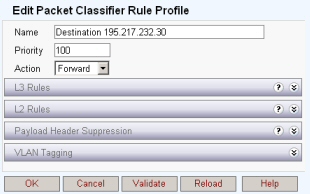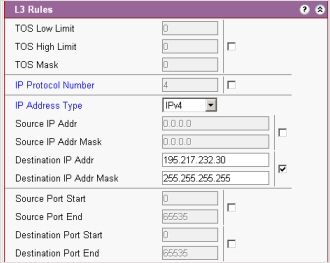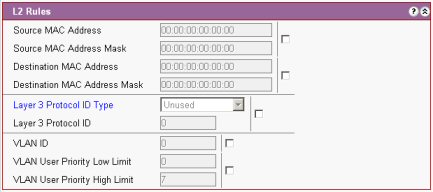 is used to set a rule. If the tick box is not checked
the values cannot be changed and rule will not be set.
is used to set a rule. If the tick box is not checked
the values cannot be changed and rule will not be set.The Packet Classifier sets the rules used to classify the packets based on their associated scheduling and QoS rules defined in the Service Flow. In other words the classification decides what service flow will be used to transmit the classified packet. For example VoIP packets can be given a higher priority/QoS than web traffic through the detection of a specific destination I/P address.
Note: In this template a tick
box  is used to set a rule. If the tick box is not checked
the values cannot be changed and rule will not be set.
is used to set a rule. If the tick box is not checked
the values cannot be changed and rule will not be set.

Name: Length 2 to 64 characters. Allowed characters 0 to 9, A to Z, a to z, ., #, -, _
Priority: The value specifies the priority for the Classifier, which is used for determining the order of the Classifier. A higher value indicates higher priority. Classifiers may have priorities in the range 0 to 255.
Action: Select to forward the packet or discard the packet.

TOS Low Limit: Specifies the lower limit of a ToS range (used where a mask cannot be applied, for example when the lower limit is 5 = 101) to which a QoS rule will apply. Range = 0 to 255.
TOS High Limit: Specifies the higher limit of a ToS range to which a QoS rule will apply. Range = 0 to 255.
TOS Mask: Specifies a range of a ToS bits to which a QoS rule will apply. The mask value is used to check range checking of TosLow and TosHigh. Range = 0 to 255. The TOS Mask is only defined for IP, TCP and UDP rules. The TOS Mask can be used to compare specific bits (Precedence/Type of Service) from the TOS field in the IP header of a packet against the TOS value entered for this rule.
IP Protocol Number: Allows UDP, TCP, ICMP protocols to be relatively prioritised. This object indicates the value of the IP Protocol field required for IP packets to match this rule. See IP Protocol Numbers
IP Address Type IP: Specifies whether IPv4 or IPv6 will be used to create rules elsewhere. MicroMAX and SS do not support IPv6 based classifiers. See also IP Address Type
Source IP Addr: Defines a specific source IP address to which a QoS rule will apply. If the referenced parameter is not present in a classifier,this object reports the value of ipv4.
Source IP Addr Mask: Defines a range of source IP addresses to which a QoS rule will apply. This object specifies the value of the IP Source Address required for packets to match this rule. Default value = 0.0.0.0.
Destination IP Addr: Defines a specific destination IP address to which a QoS rule will apply.
Destination IP Addr Mask: This object specifies the value of the IP Destination Address required for packets to match this rule.
Source Port Start: This object specifies the low end inclusive range of TCP/UDP source port numbers to which a packet is compared. This object is irrelevant for non-TCP/UDP IP packets. Default value = 0.
Source Port End: This object specifies the high end inclusive range of TCP/UDP source port numbers to which a packet is compared. This object is irrelevant for non-TCP/UDP IP packets.Default value = 65535.
Destination Port Start: This object specifies the low end inclusive range of TCP/UDP destination port numbers to which a packet is compared. This object is irrelevant for non-TCP/UDP IP packets. Default value = 0.
Destination Port End: This object specifies the high end inclusive range of TCP/UDP destination port numbers to which a packet is compared. This object is irrelevant for non-TCP/UDP IP packets. Default value = 65535.

Source Mac Address: IEEE802.3/Ethernet Source MAC Address
Source MAC Address Mask: IEEE802.3/Ethernet Source MAC mask
Destination MAC Address: IEEE802.3/Ethernet Destination MAC Address
Destination MAC Address Mask: IEEE802.3/Ethernet Destination MAC mask
Layer 3 Protocol ID Type: Specified whether a QoS rule is to be applied to a link layer control (LLC) of either Ethertype/SNAP or DSAP.
Unused : Layer 3 protocol type not used as a matching criteria.
Ethertype/SNAP : Ethertype [ Dec-Intel-Xerox (DIX) encapsulation] or the RFC1042 Sub-Network Access Protocol (SNAP) encapsulation formats.
DSAP: The rule applies only to frames using the IEEE802.3 encapsulation format with a Destination Service Access Point (DSAP) other than 0xAA (which is reserved for SNAP).
Layer 3 Protocol ID: Ethertype [a hexadecimal number in the range 0000 to FFFF} or a DSAP number [in the range 00 to FF]
VLAN ID: This applies only to Ethernet frames using the 802.1P/Q tag header. If this object's value is nonzero, tagged packets must have a VLAN Identifier that matches the value in order to match the rule. Range = 0 to 4095.
VLAN User Priority Low Limit: This object applies only to Ethernet frames using the 802.1P/Q tag header Tagged Ethernet packets must have a 3-bit Priority field within the range of the low and high limit. This field sets the Low Limit. Range 0(low) to 7
VLAN User Priority High Limit: This object applies only to Ethernet frames using the 802.1P/Q tag header Tagged Ethernet packets must have a 3-bit Priority field within the range of the low and high limit. This field sets the High Limit. Range 0 to 7(high)

In payload header suppression the repetitive portion of the higher layer is compressed by the sending entity and restored by the receiving entity. On the uplink the sending entity is the SS and the receiving entity is the BS TRx, on the downlink the sending entity is the BS TRx and the receiving entity is the SS. For more information refer to the 802.16 5.2.3.1
PHS Size: Default 0. The PHS size is automatically assigned and is equivalent to the number of bytes in the payload suppression Field and on the number of valid bits in the PHS Mask. Max size =255
PHS Mask: The PHS mask determines which bytes are not suppressed.
PHS Verify: Enable/Disable

Tagging Behavior: Enabled or Disabled.
Tag VLAN ID: VLAN ID number
Tag VLAN User Priority: VLAN User Priority
See Action Buttons